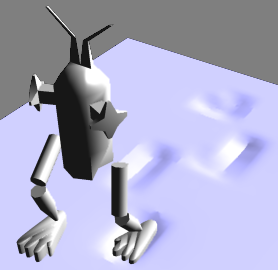The main reason for creating soft-body objects is have them collide with obstacles. To get the best results, make sure both the obstacle object and the soft-body object have the same amount of subdivisions for their geometry. The higher the subdivision, the more accurate the collision.
As well, if you have soft body applied on individual clusters on an object, make sure to select the whole object (not the clusters) when you select the obstacle for it.

This Robot deforms a floor that is defined as a soft-body object.
Select the soft-body objects (not clusters or tagged points) that you want to have collide with the obstacles.
From the Simulate toolbar, choose Modify  Soft Body
Soft Body  Set Obstacle.
Set Obstacle.
Pick one or more objects in the scene that will act as obstacles for the soft body object. Right-click to end the picking session.
Set the general and physical parameters in the Obstacle property editor to set up the obstacle and control the collision's behavior (see Obstacle Property Editor [Properties Reference] for information).
Pay special attention to these parameters in the Obstacle property editor:
Be sure to correctly set the Obstacle Type parameter. If this parameter is set to Actual Shape, for example, the deformed object will mold itself to the actual shape of the obstacle upon collision.
This may be appropriate in some cases, but it is time-consuming. If the soft-body object is striking a flat obstacle, for example, a bounding-plane setting would be a better, more economical choice.
To prevent an obstacle from passing through or pushing into the soft-body object too much, use a greater Push Length value. This creates an offset between the obstacle and whatever is colliding with it.
Set the Friction parameter to a high value if you want the soft-body object to stick to the obstacle. A low value causes the object to slide off the obstacle with little resistance. For example, set this value to 1 if you want to make a ball roll on a floor.
When you play the simulation, the soft-body object collides with the obstacle.
 Except where otherwise noted, this work is licensed under a Creative Commons Attribution-NonCommercial-ShareAlike 3.0 Unported License
Except where otherwise noted, this work is licensed under a Creative Commons Attribution-NonCommercial-ShareAlike 3.0 Unported License